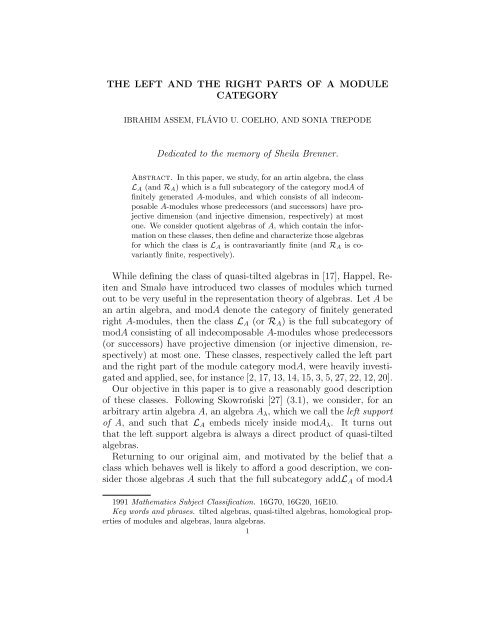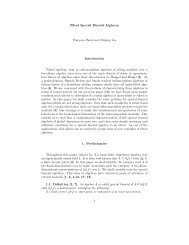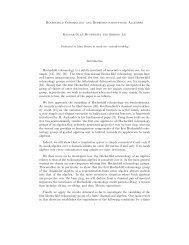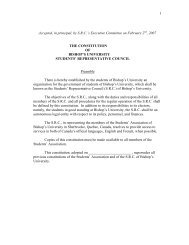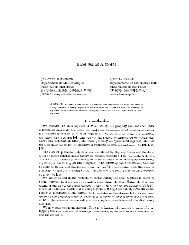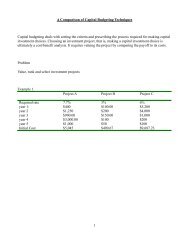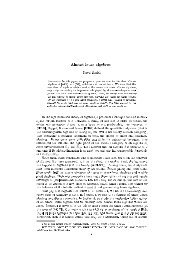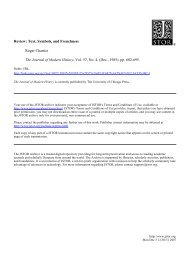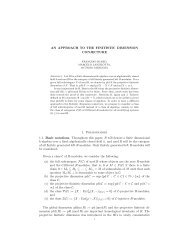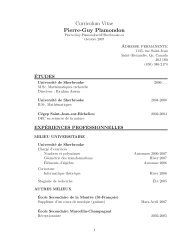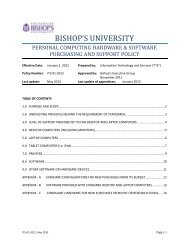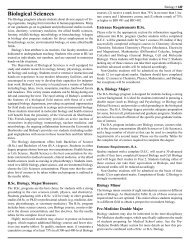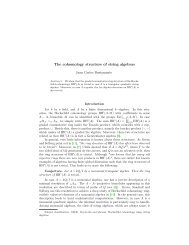The left and the right parts of a module category - Université de ...
The left and the right parts of a module category - Université de ...
The left and the right parts of a module category - Université de ...
You also want an ePaper? Increase the reach of your titles
YUMPU automatically turns print PDFs into web optimized ePapers that Google loves.
THE LEFT AND THE RIGHT PARTS OF A MODULE<br />
CATEGORY<br />
IBRAHIM ASSEM, FLÁVIO U. COELHO, AND SONIA TREPODE<br />
Dedicated to <strong>the</strong> memory <strong>of</strong> Sheila Brenner.<br />
Abstract. In this paper, we study, for an artin algebra, <strong>the</strong> class<br />
L A (<strong>and</strong> R A ) which is a full sub<strong>category</strong> <strong>of</strong> <strong>the</strong> <strong>category</strong> modA <strong>of</strong><br />
finitely generated A-<strong>module</strong>s, <strong>and</strong> which consists <strong>of</strong> all in<strong>de</strong>composable<br />
A-<strong>module</strong>s whose pre<strong>de</strong>cessors (<strong>and</strong> successors) have projective<br />
dimension (<strong>and</strong> injective dimension, respectively) at most<br />
one. We consi<strong>de</strong>r quotient algebras <strong>of</strong> A, which contain <strong>the</strong> information<br />
on <strong>the</strong>se classes, <strong>the</strong>n <strong>de</strong>fine <strong>and</strong> characterize those algebras<br />
for which <strong>the</strong> class is L A is contravariantly finite (<strong>and</strong> R A is covariantly<br />
finite, respectively).<br />
While <strong>de</strong>fining <strong>the</strong> class <strong>of</strong> quasi-tilted algebras in [17], Happel, Reiten<br />
<strong>and</strong> Smalø have introduced two classes <strong>of</strong> <strong>module</strong>s which turned<br />
out to be very useful in <strong>the</strong> representation <strong>the</strong>ory <strong>of</strong> algebras. Let A be<br />
an artin algebra, <strong>and</strong> modA <strong>de</strong>note <strong>the</strong> <strong>category</strong> <strong>of</strong> finitely generated<br />
<strong>right</strong> A-<strong>module</strong>s, <strong>the</strong>n <strong>the</strong> class L A (or R A ) is <strong>the</strong> full sub<strong>category</strong> <strong>of</strong><br />
modA consisting <strong>of</strong> all in<strong>de</strong>composable A-<strong>module</strong>s whose pre<strong>de</strong>cessors<br />
(or successors) have projective dimension (or injective dimension, respectively)<br />
at most one. <strong>The</strong>se classes, respectively called <strong>the</strong> <strong>left</strong> part<br />
<strong>and</strong> <strong>the</strong> <strong>right</strong> part <strong>of</strong> <strong>the</strong> <strong>module</strong> <strong>category</strong> modA, were heavily investigated<br />
<strong>and</strong> applied, see, for instance [2, 17, 13, 14, 15, 3, 5, 27, 22, 12, 20].<br />
Our objective in this paper is to give a reasonably good <strong>de</strong>scription<br />
<strong>of</strong> <strong>the</strong>se classes. Following Skowroński [27] (3.1), we consi<strong>de</strong>r, for an<br />
arbitrary artin algebra A, analgebraA λ ,whichwecall<strong>the</strong><strong>left</strong> support<br />
<strong>of</strong> A, <strong>and</strong>suchthatL A embeds nicely insi<strong>de</strong> modA λ . It turns out<br />
that <strong>the</strong> <strong>left</strong> support algebra is always a direct product <strong>of</strong> quasi-tilted<br />
algebras.<br />
Returning to our original aim, <strong>and</strong> motivated by <strong>the</strong> belief that a<br />
class which behaves well is likely to afford a good <strong>de</strong>scription, we consi<strong>de</strong>r<br />
those algebras A such that <strong>the</strong> full sub<strong>category</strong> addL A <strong>of</strong> modA<br />
1991 Ma<strong>the</strong>matics Subject Classification. 16G70, 16G20, 16E10.<br />
Key words <strong>and</strong> phrases. tilted algebras, quasi-tilted algebras, homological properties<br />
<strong>of</strong> <strong>module</strong>s <strong>and</strong> algebras, laura algebras.<br />
1
2 ASSEM, COELHO, AND TREPODE<br />
having as objects <strong>the</strong> direct sums <strong>of</strong> <strong>module</strong>s in L A is contravariantly<br />
finite (in <strong>the</strong> sense <strong>of</strong> Ausl<strong>and</strong>er <strong>and</strong> Smalø [9]) <strong>and</strong> call such algebras<br />
<strong>left</strong> supported. Right supported algebras are <strong>de</strong>fined dually by requiring<br />
that addR A be covariantly finite. Contravariantly <strong>and</strong> covariantly finite<br />
subcategories have been very useful in <strong>the</strong> representation <strong>the</strong>ory<br />
<strong>of</strong> algebras, see, for instance, [8, 9, 6]. This paper is mainly <strong>de</strong>voted to<br />
<strong>the</strong> study <strong>of</strong> (<strong>left</strong>) supported algebras.<br />
As we shall see, <strong>the</strong>re exist many classes <strong>of</strong> algebras which are <strong>left</strong><br />
supported such as, for instance, <strong>the</strong> laura algebras <strong>of</strong> [2, 3, 5, 22, 27]<br />
as well as many classes <strong>of</strong> tilted algebras.<br />
We now state our results. We start with an arbitrary artin algebra<br />
A, <strong>and</strong> <strong>de</strong>scribe explicitly a <strong>module</strong> E, which we prove to be <strong>the</strong> direct<br />
sum <strong>of</strong> a complete set <strong>of</strong> representatives <strong>of</strong> <strong>the</strong> isomorphism classes <strong>of</strong><br />
in<strong>de</strong>composable Ext-injectives in <strong>the</strong> sub<strong>category</strong> addL A .Ifweaddto<br />
this <strong>module</strong> <strong>the</strong> direct sum <strong>of</strong> a complete set <strong>of</strong> representatives <strong>of</strong> <strong>the</strong><br />
isomorphism classes <strong>of</strong> <strong>the</strong> in<strong>de</strong>composable projectives not lying in L A ,<br />
we get a partial tilting <strong>module</strong> T = E ⊕ F . This leads us to our first<br />
main <strong>the</strong>orem.<br />
<strong>The</strong>orem (A). Let A be an artin algebra. <strong>The</strong> following conditions<br />
are equivalent:<br />
(a) A is <strong>left</strong> supported.<br />
(b) addL A coinci<strong>de</strong>s with <strong>the</strong> class CogenE <strong>of</strong> <strong>the</strong> A-<strong>module</strong>s cogenerated<br />
by E.<br />
(c) T = E ⊕ F is a tilting <strong>module</strong>.<br />
<strong>The</strong> <strong>module</strong> T above generalizes <strong>the</strong> canonical tilting <strong>module</strong> constructed<br />
for shod algebras in [12] <strong>and</strong> thus our <strong>the</strong>orem can be read as<br />
a generalization <strong>of</strong> <strong>the</strong> results in [12].<br />
We next return to our original aim, namely to give a good <strong>de</strong>scription<br />
<strong>of</strong> <strong>the</strong> <strong>module</strong>s <strong>and</strong> <strong>the</strong> irreducible morphisms in L A , <strong>and</strong> achieve this<br />
as follows: let A λ be <strong>the</strong> <strong>left</strong> support <strong>of</strong> A. <strong>The</strong>n E has a natural<br />
A λ -<strong>module</strong> structure, <strong>and</strong> we have.<br />
<strong>The</strong>orem (B). Let A be an artin algebra. <strong>The</strong>n A is <strong>left</strong> supported if<br />
<strong>and</strong> only if each connected component <strong>of</strong> A λ is a tilted algebra <strong>and</strong> <strong>the</strong><br />
restriction <strong>of</strong> E to this component is a slice <strong>module</strong>.<br />
This paper is organized as follows. After a brief preliminary section,<br />
we look at <strong>the</strong> <strong>left</strong> support <strong>of</strong> an artin algebra in Section 2, <strong>the</strong>n we<br />
study <strong>the</strong> in<strong>de</strong>composable Ext-injectives in L A in Section 3. <strong>The</strong> next<br />
two sections are respectively <strong>de</strong>voted to proving our two <strong>the</strong>orems.
LEFT AND RIGHT PARTS 3<br />
1. Preliminaries<br />
1.1. Notation. Throughout this paper, all our algebras are artin algebras.<br />
For an algebra A, we<strong>de</strong>notebymodA its <strong>category</strong> <strong>of</strong> finitely<br />
generated <strong>right</strong> A-<strong>module</strong>s. For a full sub<strong>category</strong> C <strong>of</strong> modA, we<strong>de</strong>note<br />
by indC afullsub<strong>category</strong><strong>of</strong>modA having as objects a full set <strong>of</strong><br />
representatives <strong>of</strong> <strong>the</strong> isomorphism classes <strong>of</strong> <strong>the</strong> in<strong>de</strong>composable objects<br />
in C, <strong>and</strong> we abbreviate ind(modA) asindA. Also, we <strong>de</strong>note by<br />
addC <strong>the</strong> full sub<strong>category</strong> <strong>of</strong> modA having as objects <strong>the</strong> direct sums<br />
<strong>of</strong> in<strong>de</strong>composable summ<strong>and</strong>s <strong>of</strong> objects in C, <strong>and</strong>, if M is a <strong>module</strong>,<br />
we abbreviate add{M} as addM. We <strong>de</strong>note by rk(K 0 (A)) <strong>the</strong> rank<br />
<strong>of</strong> <strong>the</strong> Gro<strong>the</strong>ndieck group <strong>of</strong> A, which equals <strong>the</strong> number <strong>of</strong> isomorphism<br />
classes <strong>of</strong> simple A-<strong>module</strong>s. If M is an A-<strong>module</strong>, we <strong>de</strong>note<br />
by pd A M (or id A M) its projective dimension (or injective dimension,<br />
respectively). Also, we <strong>de</strong>note by gl.dim.A <strong>the</strong> global dimension <strong>of</strong> A.<br />
An algebra B is called a full sub<strong>category</strong> <strong>of</strong> A if <strong>the</strong>re exists an i<strong>de</strong>mpotent<br />
e ∈ A such that B = eAe. It is called convex in A if, whenever<br />
<strong>the</strong>re exists a sequence e i = e i0 ,e i1 , ··· ,e it = e j <strong>of</strong> primitive orthogonal<br />
i<strong>de</strong>mpotents such that e il+1 Ae il ≠ 0 for 0 ≤ l
4 ASSEM, COELHO, AND TREPODE<br />
τ A M i+1 ≠ M i−1 for all 1
LEFT AND RIGHT PARTS 5<br />
(b) L A consists <strong>of</strong> <strong>the</strong> <strong>module</strong>s N ∈ indA such that, if <strong>the</strong>re exists<br />
a path from an in<strong>de</strong>composable injective <strong>module</strong> to N, <strong>the</strong>n this<br />
path can be refined to a path <strong>of</strong> irreducible morphisms, <strong>and</strong> any<br />
such path <strong>of</strong> irreducible morphisms is sectional.<br />
1.5. Lemma. Let A be an artin algebra, <strong>and</strong> Γ be a component <strong>of</strong><br />
Γ(modA).<br />
(a) If Γ contains projective <strong>module</strong>s, <strong>the</strong>n R A ∩ Γ is directed.<br />
(b) If Γ contains injective <strong>module</strong>s, <strong>the</strong>n L A ∩ Γ is directed.<br />
Pro<strong>of</strong>. (a) Assume M ∈R A ∩ Γ, <strong>and</strong> that M = M 0 −→ · · · −→ M t =<br />
M is a cycle. By (1.2), <strong>the</strong>re exists a path M = N 0 −→ ··· −→<br />
N s = P ,whereP is projective. By (1.3)(a), <strong>the</strong> composed path M =<br />
M 0 −→ ··· −→ M t = M = N 0 −→ ··· −→ N s = P is refinable to<br />
a sectional path <strong>of</strong> irreducible morphisms. But this contradicts <strong>the</strong><br />
non-sectionality <strong>of</strong> cycles [10, 11, 18].<br />
□<br />
1.6. Corollary. Let A be a representation-finite artin algebra. <strong>The</strong>n<br />
L A <strong>and</strong> R A are directed.<br />
2. <strong>The</strong> <strong>left</strong> <strong>and</strong> <strong>right</strong> support algebras.<br />
[ ]<br />
B 0<br />
2.1. Proposition. Let A =<br />
be an artin algebra written<br />
M C<br />
in triangular matrix form. <strong>The</strong>n L A ⊆L B if <strong>and</strong> only if, for each<br />
primitive i<strong>de</strong>mpotent e c ∈ C, <strong>the</strong> corresponding projective A-<strong>module</strong> P c<br />
does not lie in L A .<br />
Pro<strong>of</strong>. Sufficiency. We first observe that L A ⊆ indB. In<strong>de</strong>ed, if<br />
X ∈L A <strong>and</strong> does not lie in indB, <strong>the</strong>n <strong>the</strong>re exists an i<strong>de</strong>mpotent<br />
e c ∈ C such that <strong>the</strong>re exists a non-zero morphism P c −→ X. However,<br />
P c /∈L A <strong>and</strong> X ∈L A contradict <strong>the</strong> fact that L A is closed un<strong>de</strong>r<br />
pre<strong>de</strong>cessors.<br />
Let now X ∈L A . We claim that <strong>the</strong> full subcategories Pred A X <strong>and</strong><br />
Pred B X consisting <strong>of</strong> <strong>the</strong> pre<strong>de</strong>cessors <strong>of</strong> X in modA <strong>and</strong> modB respectively,<br />
coinci<strong>de</strong>. It is clear that Pred B X ⊆ Pred A X. Let Y ∈<br />
Pred A X, <strong>the</strong>n <strong>the</strong>re exists a path Y = Y 0 −→ Y 1 −→ ··· −→ Y t = X<br />
in indA. However, X ∈L A , hence each Y i ∈L A . Since L A ⊆ indB,<br />
this means that each Y i is a B-<strong>module</strong>. <strong>The</strong>refore, Y ∈ Pred B X.This<br />
establishes our claim.<br />
In or<strong>de</strong>r to show that X ∈L B , we assume that Y is a pre<strong>de</strong>cessor <strong>of</strong> X.<br />
Since Y prece<strong>de</strong>s X in L A , <strong>the</strong>re exists a minimal projective resolution<br />
in modA<br />
0 −→ P 1 −→ P 0 −→ Y −→ 0
6 ASSEM, COELHO, AND TREPODE<br />
Since Y ∈L A ,<strong>the</strong>nP 0 ,P 1 ∈ addL A . <strong>The</strong>refore P 0 ,P 1 are projective<br />
B-<strong>module</strong>s. Hence pdY B ≤ 1<strong>and</strong>X ∈L B .Thus,L A ⊆L B .<br />
Necessity. Let e c ∈ C be a primitive i<strong>de</strong>mpotent such that P c ∈L A .<br />
<strong>The</strong>n L A ⊆L B yields P c ∈L B <strong>and</strong> in particular is a B-<strong>module</strong>, an<br />
absurdity.<br />
□<br />
2.2. Definition. (see [27] (3.1)) Let A be an artin algebra, <strong>and</strong> P<br />
<strong>de</strong>note <strong>the</strong> direct sum <strong>of</strong> a full set <strong>of</strong> representatives <strong>of</strong> <strong>the</strong> isomorphism<br />
classes <strong>of</strong> in<strong>de</strong>composable projectives lying in L A . <strong>The</strong> algebra A λ =<br />
EndP A is called <strong>the</strong> <strong>left</strong> support <strong>of</strong> A. We <strong>de</strong>fine dually <strong>the</strong> <strong>right</strong> support<br />
A ρ <strong>of</strong> A.<br />
Remarks. (a) A λ is a full convex sub<strong>category</strong> <strong>of</strong> A closed un<strong>de</strong>r<br />
successors. In<strong>de</strong>ed, if P x ∈ L A is projective <strong>and</strong> P x0 −→ P x1 −→<br />
···−→P xt = P x is a path in indA between projectives, <strong>the</strong>n P xi ∈L A<br />
for each i.<br />
(b) Any in<strong>de</strong>composable in L A has a canonical A λ -<strong>module</strong> structure<br />
(that is, L A ⊆ indA λ ): in<strong>de</strong>ed, if X ∈L A <strong>and</strong> P x is an in<strong>de</strong>composable<br />
projective <strong>module</strong> such that Hom A (P x ,X) ≠0,<strong>the</strong>nP x ∈L A .<br />
(c) In general, <strong>the</strong> subcategories A λ <strong>and</strong> A ρ may intersect: if A is <strong>the</strong><br />
radical square zero algebra given by <strong>the</strong> quiver<br />
<br />
1<br />
✟<br />
✟<br />
✟✙ ✛<br />
2<br />
<br />
❍❨<br />
❍<br />
❍<br />
<strong>the</strong>n A λ is <strong>the</strong> full convex sub<strong>category</strong> generated by <strong>the</strong> points {1, 2}<br />
while A ρ is generated by {2, 3}.<br />
(d) <strong>The</strong> <strong>left</strong> support <strong>of</strong> a tilted (or, more generally, <strong>of</strong> a laura but not<br />
quasi-tilted) algebra does not coinci<strong>de</strong> with <strong>the</strong> <strong>left</strong> end algebra (see<br />
[19] <strong>and</strong> [2], respectively): in<strong>de</strong>ed, if A is tilted, <strong>the</strong>n A = A λ = A ρ .<br />
2.3. Corollary. ([27](3.1)) Let A be an artin algebra. <strong>The</strong>n A λ <strong>and</strong><br />
A ρ are direct products <strong>of</strong> connected quasi-tilted algebras.<br />
Pro<strong>of</strong>. It follows from Remark (2.2)(a) that A can be written in triangular<br />
matrix form<br />
[ ]<br />
Aλ 0<br />
A =<br />
M C<br />
By (2.1), L A ⊆L Aλ . Observe also that <strong>the</strong> projective A λ -<strong>module</strong>s coinci<strong>de</strong><br />
with <strong>the</strong> projective A-<strong>module</strong>s. Thus, if P is an in<strong>de</strong>composable<br />
<br />
3
LEFT AND RIGHT PARTS 7<br />
A λ -<strong>module</strong>, we have P ∈L Aλ . Applying [17](II.1.14) yields that each<br />
connected component <strong>of</strong> A λ is quasi-tilted.<br />
□<br />
2.4. <strong>The</strong>orem. Let A be a triangular artin algebra. <strong>The</strong>n <strong>the</strong>re exists<br />
a filtration A 0 ⊆ A 1 ⊆ ··· ⊆ A t = A, withA 0 a direct product <strong>of</strong><br />
connected quasi-tilted algebras, <strong>and</strong> <strong>module</strong>s M i in modA i such that<br />
A i+1 = A i [M i ] <strong>and</strong> M i /∈ addL Ai+1 ,foreachi such that 0 ≤ i
8 ASSEM, COELHO, AND TREPODE<br />
Since <strong>the</strong> converse is clear, <strong>the</strong> statement is proved.<br />
(b) Necessity. Clearly, M ∈Eimplies that M ∈L A . If M ∈E 1 ,<strong>the</strong>n<br />
ei<strong>the</strong>r M is injective (in which case it is automatically Ext-injective<br />
in L A ) or, else, <strong>the</strong>re exist an in<strong>de</strong>composable injective I <strong>and</strong> a path<br />
I ❀ M −→ ∗ −→ τA<br />
−1 M in indA. This path is not sectional, hence,<br />
by (1.4), τA<br />
−1 M /∈L A .IfM ∈E 2 , <strong>the</strong>re exists a path P ❀ τA<br />
−1 M with<br />
P /∈L A projective. Hence, τA −1 M/∈L A .<br />
Sufficiency. Assume M /∈E 1 to be Ext-injective in addL A . We must<br />
show that M ∈E 2 .SinceτA<br />
−1 M/∈L A ,<strong>the</strong>nτA<br />
−1 M has a pre<strong>de</strong>cessor L<br />
such that pd A L ≥ 2.<br />
Let N 1 = τA<br />
−1 M. Ifpd A N 1 ≥ 2, <strong>the</strong>n<br />
Hom A (D(A),M) ∼ = Hom A (D(A),τ A N 1 ) ≠0<br />
gives M ∈E 1 , a contradiction. Thus, pd A N 1 ≤ 1<strong>and</strong><strong>the</strong>reexistsa<br />
path L ❀ N 1 , which factors through one <strong>of</strong> <strong>the</strong> middle terms N 2 <strong>of</strong> <strong>the</strong><br />
almost split sequence ending with N 1 .<br />
Since L prece<strong>de</strong>s N 2 ,<strong>the</strong>nN 2 /∈L A . We claim that pd A N 2 ≤ 1. In<strong>de</strong>ed,<br />
if pd A N 2 ≥ 2, <strong>the</strong>n Hom A (D(A),τ A N 2 ) ≠ 0 gives an injective I <strong>and</strong><br />
apathI ❀ τ A N 2 −→ M in indA, soM ∈E 1 , a contradiction which<br />
proves our claim.<br />
Now, if N 2 is projective, <strong>the</strong>n M ∈E 2 <strong>and</strong> we are done. We may thus<br />
assume that N 2 is not projective.<br />
Inductively, if N 1 , ··· ,N i−1 are not projective, we construct in this way<br />
apath<br />
(∗)<br />
N i −→ · · · −→ N 2 −→ N 1 = τA<br />
−1 M<br />
in indA, withN 1 , ··· ,N i /∈L A <strong>and</strong> pd A N j ≤ 1 for all j. We now show<br />
that this path is sectional: in<strong>de</strong>ed, if this is not <strong>the</strong> case, <strong>the</strong>n <strong>the</strong>re<br />
exists a least in<strong>de</strong>x j ≤ i − 1 such that N j −→ · · · −→ N 1 is sectional,<br />
while N j+1 = τ A N j−1 . But, in this case, we get a path<br />
N j+1 = τ A N j−1 −→ · · · −→ τ A N 2 −→ M = τ A N 1<br />
in indA, <strong>and</strong> this yields a contradiction, since M ∈L A would <strong>the</strong>n<br />
imply N j+1 ∈L A .<br />
It follows from [10, 11, 18] <strong>and</strong> from <strong>the</strong> sectionality <strong>of</strong> <strong>the</strong> path (∗)<br />
that <strong>the</strong> <strong>module</strong>s N j are pairwise non-isomorphic.<br />
Assume now that i ≥ 1+ rk(K 0 (A)). By [26], <strong>the</strong>re exist p, q such that<br />
Hom A (N p ,τ A N q ) ≠0. We<strong>the</strong>nget,asabove,N p ∈L A , a contradiction.<br />
<strong>The</strong>refore i ≤ rk(K 0 (A)). This shows that <strong>the</strong> above construction stops<br />
after at most rk(K 0 (A)) steps. Thus, <strong>the</strong>re is an in<strong>de</strong>x j such that N j<br />
is a projective <strong>module</strong>. Since N j /∈L A , this implies M ∈E 2 . □
LEFT AND RIGHT PARTS 9<br />
3.2. Corollary. Any path <strong>of</strong> irreducible morphisms in E is sectional.<br />
Pro<strong>of</strong>. Assume M 0 −→ M 1 −→ · · · −→ M t is a path <strong>of</strong> irreducible<br />
morphisms, with M i ∈Efor all i. If M i+1 = τA<br />
−1 M i−1 ,<strong>the</strong>nsincewe<br />
have τA −1 M i−1 /∈L A because <strong>of</strong> <strong>the</strong> Ext-injectivity <strong>of</strong> M i−1 , <strong>the</strong> fact<br />
that M i+1 ∈L A yields a contradiction.<br />
□<br />
3.3. We now <strong>de</strong>note by E <strong>the</strong> direct sum <strong>of</strong> all in<strong>de</strong>composable A-<br />
<strong>module</strong>s lying in E, byF <strong>the</strong> direct sum <strong>of</strong> a full set <strong>of</strong> representatives<br />
<strong>of</strong> <strong>the</strong> isomorphism classes <strong>of</strong> in<strong>de</strong>composable projective A-<strong>module</strong>s not<br />
lying in L A , <strong>and</strong> we set T = E ⊕ F .<br />
Lemma. With <strong>the</strong> above notations, T = E ⊕ F is a partial tilting<br />
A-<strong>module</strong>. It is a tilting <strong>module</strong> if <strong>and</strong> only if <strong>the</strong> number <strong>of</strong> in<strong>de</strong>composable<br />
summ<strong>and</strong>s <strong>of</strong> E equals <strong>the</strong> number <strong>of</strong> isomorphism classes <strong>of</strong><br />
in<strong>de</strong>composable projectives lying in L A .<br />
Pro<strong>of</strong>. Clearly, pd A T ≤ 1. It follows from <strong>the</strong> Ext-injectivity <strong>of</strong> E that<br />
Ext 1 A(E,E) = 0. In or<strong>de</strong>r to prove that T is a partial tilting <strong>module</strong><br />
<strong>the</strong>re only remains to show that Ext 1 A(E,F) = 0. Since F /∈ addL A ,<br />
we have, for every M ∈L A ,thatτ A M ∈L A . Hence<br />
Ext 1 A(M,F) ∼ = DHom A (F, τ A M)=0<br />
because pd A M ≤ 1 (see [23]). This implies our statement.<br />
Now, <strong>the</strong> partial tilting <strong>module</strong> T is a tilting <strong>module</strong> if <strong>and</strong> only if<br />
<strong>the</strong> number <strong>of</strong> isomorphism classes <strong>of</strong> its summ<strong>and</strong>s equals <strong>the</strong> number<br />
<strong>of</strong> isomorphism classes <strong>of</strong> in<strong>de</strong>composable projective A-<strong>module</strong>s. <strong>The</strong><br />
second statement follows at once.<br />
□<br />
3.4. Proposition. Assume that M ∈E <strong>and</strong> that <strong>the</strong>re exists a path<br />
M ❀ N, withN ∈L A . <strong>The</strong>n this path can be refined to a sectional<br />
path <strong>of</strong> irreducible morphisms <strong>and</strong> N ∈E. In particular, E is convex<br />
in modA.<br />
Pro<strong>of</strong>. <strong>The</strong>re are two cases to consi<strong>de</strong>r. Assume first that M ∈E 1 .<br />
Hence, <strong>the</strong>re exist an injective I <strong>and</strong> a path I ❀ M in indA. Since<br />
N ∈L A , it follows from (1.4) that <strong>the</strong> path I ❀ M ❀ N is refinable<br />
to a sectional path <strong>of</strong> irreducible morphisms. Hence N ∈E 1 ⊆E.<br />
Assume now M ∈E 2 . If <strong>the</strong> given path<br />
f<br />
(∗) M = M<br />
1<br />
f t<br />
0 −→ M1 −→··· −→ Mt = N<br />
factors through an in<strong>de</strong>composable injective I, <strong>the</strong>n <strong>the</strong> subpath I ❀ N<br />
lies in E 1 . We may thus assume that none <strong>of</strong> <strong>the</strong> M i is injective <strong>and</strong><br />
that none <strong>of</strong> <strong>the</strong> morphisms f i factors through an injective. Hence, for
10 ASSEM, COELHO, AND TREPODE<br />
each i, Hom A (M i ,M i+1 )=Hom A (M i ,M i+1 ).<br />
formula <strong>the</strong>n yields<br />
Hom A (τ −1<br />
A<br />
<strong>The</strong> Ausl<strong>and</strong>er-Reiten<br />
M i ,τA<br />
−1 M i+1 ) ∼ = Hom A (M i ,M i+1 ) ≠0<br />
This yields a path<br />
(∗∗) τA<br />
−1 M 0 −→ τA<br />
−1 M 1 −→···−→τ A<br />
−1 M t = τA<br />
−1 N<br />
in indA. Now, all <strong>module</strong>s on (∗) lie in L A (because N does), while no<br />
<strong>module</strong> on (∗∗) belongs to L A (because all are successors <strong>of</strong> a projective<br />
not in L A ). <strong>The</strong>refore, all M i are Ext-injective in addL A , that is, all<br />
belong to E. This shows, in particular, that E is convex in modA.<br />
In or<strong>de</strong>r to show that <strong>the</strong> path (∗) can be refined to a sectional path <strong>of</strong><br />
irreducible morphisms, it suffices, in view <strong>of</strong> (3.2), to show that none<br />
<strong>of</strong> <strong>the</strong> f i lies in <strong>the</strong> infinite radical rad ∞ (modA) <strong>of</strong> <strong>the</strong> <strong>category</strong> modA.<br />
However, if f i ∈ rad ∞ A (M i−1 ,M i ) <strong>the</strong>n, for any s ≥ 1, <strong>the</strong> given path<br />
can be refined to a path<br />
M ❀ M i−1 = L 0 −→ L 1 −→···−→L s = M i ❀ N<br />
in indA. <strong>The</strong> above reasoning <strong>the</strong>n gives that all L j belong to E, <strong>and</strong><br />
this contradicts <strong>the</strong> fact that, by (3.3), <strong>the</strong> number <strong>of</strong> in<strong>de</strong>composables<br />
in E does not exceed rk(K 0 (A)).<br />
□<br />
3.5. Corollary. Assume that Γ is a component <strong>of</strong> Γ(modA) which<br />
contains an injective, <strong>the</strong>n <strong>the</strong> number <strong>of</strong> elements <strong>of</strong> E which lie in Γ<br />
is equal to <strong>the</strong> number <strong>of</strong> τ A -orbits in L A ∩ Γ.<br />
Pro<strong>of</strong>. We recall from (1.5) that L A ∩Γ is directed. We first claim that,<br />
if M ∈L A ∩ Γ, <strong>the</strong>n <strong>the</strong>re exists m>0 such that τA<br />
−m M ∈E. Assume<br />
that, for all m>0, we have τA<br />
−m M ∈L A . <strong>The</strong> directedness <strong>of</strong> L A ∩ Γ<br />
implies that M is <strong>right</strong> stable. We know that Γ contains an injective<br />
hence a walk from this injective to <strong>the</strong> τ A -orbit <strong>of</strong> M. Among all such<br />
injectives, choose one, <strong>de</strong>noted by I, such that <strong>the</strong>re is a walk <strong>of</strong> least<br />
length between I <strong>and</strong> <strong>the</strong> orbit <strong>of</strong> M. This minimality implies that<br />
all <strong>module</strong>s on this walk except I are <strong>right</strong> stable. Hence <strong>the</strong>re exists<br />
m>0 such that <strong>the</strong>re is a path from I to τA<br />
−m M. SinceτA −m M ∈L A ,<br />
<strong>the</strong>n I ∈ L A . Hence I ∈ E. By (3.4), τA<br />
−m M ∈ E, <strong>and</strong> this is a<br />
contradiction, since m can be taken arbitrarily large. This shows that<br />
<strong>the</strong>re exists m>0 such that τA<br />
−m M ∈L A but τA<br />
−m−1 M /∈L A . But<br />
<strong>the</strong>n τA −m M ∈E. This establishes our claim (see also [15](3.3)).<br />
We have proven that each τ A -orbit in L A ∩ Γ intersects E. Fur<strong>the</strong>rmore<br />
it intersects it only once: if M <strong>and</strong> τA −t M (with t>0) belong to E<br />
<strong>the</strong>n, by (3.4), all <strong>the</strong> <strong>module</strong>s on <strong>the</strong> path<br />
M −→ ∗ −→ τA<br />
−1 M −→ · · · −→ τA −t M
LEFT AND RIGHT PARTS 11<br />
belong to L A ,<strong>and</strong>τA −1 M ∈L A contradicts <strong>the</strong> Ext-injectivity <strong>of</strong> M.<br />
<strong>The</strong>refore, <strong>the</strong> number <strong>of</strong> τ A -orbits in L A ∩ Γ does not exceed <strong>the</strong> cardinality<br />
<strong>of</strong> E∩Γ. Since, clearly, any element in E∩Γ belongs to exactly<br />
one τ A -orbit in L A ∩ Γ, <strong>the</strong> statement follows.<br />
□<br />
4. Left supported algebras<br />
4.1. We recall that a tilting A-<strong>module</strong> T induces a torsion pair<br />
(T (T ), F(T )) in modA, where T (T ) = GenT is <strong>the</strong> class <strong>of</strong> all A-<br />
<strong>module</strong>s generated by T ,<strong>and</strong>F(T )={M ∈ modA: Hom A (T,M)=<br />
0}, see [1].<br />
Lemma. With <strong>the</strong> notations <strong>of</strong> (3.2), assume that T = E⊕F is a tilting<br />
<strong>module</strong>. <strong>The</strong>n F(T )=add(L A \E) <strong>and</strong> T (T )=add(indA \F(T )).<br />
Pro<strong>of</strong>. Assume M ∈L A \E, we claim that M ∈F(T ). If this is not<br />
<strong>the</strong> case, Hom A (T,M) ≠0. SinceF /∈L A ,wehaveHom A (F, M) =<br />
0. Consequently, <strong>the</strong>re exists an in<strong>de</strong>composable summ<strong>and</strong> E 0 <strong>of</strong> E<br />
such that Hom A (E 0 ,M) ≠ 0 <strong>and</strong>, since M ∈L A \E, this yields a<br />
contradiction to (3.4). This shows that L A \E ⊂ F(T ). Conversely, let<br />
N be an in<strong>de</strong>composable A-<strong>module</strong> in F(T ). <strong>The</strong>n N is cogenerated<br />
by τ A T = τ A E (see [1](2.4)). Hence <strong>the</strong>re exist an in<strong>de</strong>composable nonprojective<br />
summ<strong>and</strong> E 0 <strong>of</strong> E <strong>and</strong> a path N −→ τ A E 0 −→ ∗ −→ E 0 .<br />
Since E 0 ∈L A ,<strong>the</strong>nN ∈L A . On <strong>the</strong> o<strong>the</strong>r h<strong>and</strong>, N /∈Esince E⊂<br />
addT ⊂T(T ). This shows <strong>the</strong> first equality, <strong>and</strong> <strong>the</strong> second follows by<br />
maximality (because L A \E is closed un<strong>de</strong>r pre<strong>de</strong>cessors). □<br />
4.2. We recall that a full additive sub<strong>category</strong> C <strong>of</strong> modA is called<br />
contravariantly finite if, for any A-<strong>module</strong> M, <strong>the</strong>re exists a morphism<br />
f C : M C −→ M such that M C ∈C<strong>and</strong>, if f : N −→ M is any morphism<br />
with N ∈C, <strong>the</strong>n <strong>the</strong>re exists g : N −→ M C such that f = f C g (see<br />
[9]). <strong>The</strong> dual notion is that <strong>of</strong> covariantly finite. We observe that,<br />
since <strong>the</strong> class L A is closed un<strong>de</strong>r pre<strong>de</strong>cessors, <strong>the</strong>n addL A is trivially<br />
covariantly finite.<br />
Definition. An artin algebra A is called <strong>left</strong> supported provi<strong>de</strong>d <strong>the</strong><br />
class addL A is contravariantly finite in modA. We <strong>de</strong>fine dually <strong>right</strong><br />
supported algebras.<br />
Obviously, any representation-finite algebra is both <strong>left</strong> <strong>and</strong> <strong>right</strong><br />
supported. We <strong>de</strong>fer to later fur<strong>the</strong>r remarks <strong>and</strong> examples, we wish<br />
to prove first our main <strong>the</strong>orem <strong>of</strong> this section.<br />
<strong>The</strong>orem. Let A be an artin algebra. <strong>The</strong> following conditions are<br />
equivalent:
12 ASSEM, COELHO, AND TREPODE<br />
(a) A is <strong>left</strong> supported.<br />
(b) addL A = CogenE.<br />
(c) T = E ⊕ F is a tilting <strong>module</strong>.<br />
Pro<strong>of</strong>. (a) implies (b). By [28], <strong>the</strong>re exists a <strong>module</strong> N in modA<br />
such that addL A = CogenN. We claim that CogenN = CogenE. By<br />
[8](5.3), N is Ext-injective in addL A ,sothatN ∈ addE. Hence E ∈<br />
addL A implies<br />
addL A = CogenN ⊆ CogenE ⊆ addL A<br />
<strong>and</strong> (b) follows.<br />
(b) implies (c). By (3.1), <strong>the</strong> number <strong>of</strong> isomorphism classes <strong>of</strong> in<strong>de</strong>composable<br />
summ<strong>and</strong>s <strong>of</strong> E equals <strong>the</strong> number <strong>of</strong> isomorphism classes<br />
<strong>of</strong> in<strong>de</strong>composable Ext-injectives in addL A . Since addL A = CogenE,<br />
<strong>the</strong> latter equals <strong>the</strong> number <strong>of</strong> isomorphism classes <strong>of</strong> in<strong>de</strong>composable<br />
Ext-projectives in L A (by [8](A.6)) that is, by (3.1) again, <strong>the</strong> number<br />
<strong>of</strong> isomorphism classes <strong>of</strong> in<strong>de</strong>composable projective <strong>module</strong>s in L A .<br />
<strong>The</strong> result <strong>the</strong>n follows from (3.3).<br />
(c) implies (a). Since T is a tilting <strong>module</strong> <strong>the</strong>n, by [28], F(T )iscontravariantly<br />
finite. By (4.1), L A =indF(T ) ∪E. <strong>The</strong>refore, addL A is<br />
contravariantly finite.<br />
□<br />
4.3. Remarks <strong>and</strong> Examples. (a) <strong>The</strong> tilting <strong>module</strong> T = E ⊕ F<br />
constructed above is a generalization <strong>of</strong> <strong>the</strong> one constructed in [12] in<br />
<strong>the</strong> context <strong>of</strong> shod algebras, <strong>and</strong> our main result is a generalization <strong>of</strong><br />
[12](3.1,3.6). For this reason, T is called <strong>the</strong> canonical tilting <strong>module</strong><br />
(see also (5.4) below).<br />
(b) Let A be a tubular algebra [23], <strong>the</strong>n A is not <strong>left</strong> supported.<br />
Similarly, if A is <strong>the</strong> endomorphism algebra <strong>of</strong> a regular tilting <strong>module</strong><br />
over a wild hereditary algebra [24], <strong>the</strong>n A is not <strong>left</strong> supported. On<br />
<strong>the</strong> o<strong>the</strong>r h<strong>and</strong>, if A is tilted <strong>and</strong> has an injective in <strong>the</strong> connecting<br />
component, <strong>the</strong>n it is <strong>left</strong> supported.<br />
(c) <strong>The</strong> class <strong>of</strong> <strong>left</strong> supported algebras is not closed un<strong>de</strong>r tilting: let<br />
A be tubular, <strong>the</strong>n <strong>the</strong>re exists a sequence <strong>of</strong> tilts so that A tilts to<br />
a representation-finite algebra A ′ .<strong>The</strong>nA ′ is <strong>left</strong> supported, but A is<br />
not.<br />
(d) As we shall see in (4.4) below, <strong>the</strong> classes <strong>of</strong> laura, weakly shod <strong>and</strong><br />
shod algebras which are not quasi-tilted, are all <strong>left</strong> supported. <strong>The</strong><br />
following is an example <strong>of</strong> a <strong>left</strong> supported algebra which belongs to<br />
nei<strong>the</strong>r <strong>of</strong> <strong>the</strong>se classes: let A be <strong>the</strong> radical square zero algebra given<br />
by <strong>the</strong> quiver
LEFT AND RIGHT PARTS 13<br />
✛ ✛ ✛ <br />
1 2 3 4<br />
(e) <strong>The</strong>re exist <strong>left</strong> supported algebras which are not <strong>right</strong> supported,<br />
such as <strong>the</strong> algebra A given by <strong>the</strong> quiver<br />
1<br />
2<br />
3<br />
<br />
8 9<br />
✛ <br />
α 2<br />
❅■<br />
α 3 <br />
❅■ α 1<br />
❅<br />
<br />
❅<br />
❅ λ ɛ δ ✠ β ❅<br />
✛ ✛ ✛ ✛ ✛ 3 β<br />
✛ 2 β<br />
✛ 1 14<br />
4 5 6 7 ❅■ 10 11 <br />
<br />
γ❅<br />
<br />
✠<br />
3 γ<br />
❅<br />
✠ 1<br />
<br />
✛ <br />
12 γ 2 13<br />
bound by <strong>the</strong> relations α 1 α 2 α 3 +β 1 β 2 β 3 +γ 1 γ 2 γ 3 =0,α 3 δ =0,β 3 δ =0,<br />
γ 3 δ =0,δɛ =0,ɛλ = 0. <strong>The</strong> same example shows that <strong>the</strong> class <strong>of</strong><br />
<strong>left</strong> supported algebras is not closed un<strong>de</strong>r taking full (even convex!)<br />
subcategories (compare with [3]).<br />
4.4. We recall that an artin algebra A is called a laura algebra [2, 27]<br />
provi<strong>de</strong>d that <strong>the</strong> class L A ∪R A is c<strong>of</strong>inite in indA. <strong>The</strong> following<br />
proposition is contained in <strong>the</strong> pro<strong>of</strong> <strong>of</strong> <strong>the</strong> main <strong>the</strong>orem <strong>of</strong> [27]. Our<br />
pro<strong>of</strong> is however different.<br />
Proposition. Let A be a laura algebra which is not quasi-tilted.<br />
<strong>The</strong>n A is <strong>left</strong> <strong>and</strong> <strong>right</strong> supported.<br />
Pro<strong>of</strong>. Let Γ <strong>de</strong>note <strong>the</strong> unique faithful, quasi-directed non-semiregular<br />
component <strong>of</strong> Γ(modA). <strong>The</strong>n Γ contains an injective. By (3.5), <strong>the</strong><br />
number <strong>of</strong> τ A -orbits <strong>of</strong> L A ∩ Γ equals <strong>the</strong> number <strong>of</strong> elements <strong>of</strong> E∩Γ.<br />
Since all injectives which lie in L A , <strong>and</strong> all in<strong>de</strong>composable projectives<br />
which do not lie in L A ,belongtoΓ,<strong>the</strong>nE⊆Γ, so E∩Γ=E. In<br />
view <strong>of</strong> (3.3), <strong>the</strong>re remains to show that <strong>the</strong> number <strong>of</strong> τ A -orbits <strong>of</strong><br />
L A ∩ Γ equals <strong>the</strong> number <strong>of</strong> isomorphism classes <strong>of</strong> in<strong>de</strong>composable<br />
projective <strong>module</strong>s lying in L A . Since, by (1.5), L A ∩ Γ is directed, <strong>and</strong><br />
since A is a laura not quasi-tilted algebra, <strong>the</strong> number <strong>of</strong> τ A -orbits <strong>of</strong><br />
L A ∩ Γ equals <strong>the</strong> sum <strong>of</strong> <strong>the</strong> number <strong>of</strong> isomorphism classes <strong>of</strong> in<strong>de</strong>composable<br />
projectives lying in L A ∩ Γplus<strong>the</strong>number<strong>of</strong>τ A -orbits
14 ASSEM, COELHO, AND TREPODE<br />
<strong>of</strong> <strong>the</strong> <strong>left</strong> stable part Γ l <strong>of</strong> Γ. By [2](4.3), <strong>the</strong> number <strong>of</strong> τ A -orbits<br />
<strong>of</strong> Γ l equals <strong>the</strong> number <strong>of</strong> isomorphism classes <strong>of</strong> <strong>the</strong> in<strong>de</strong>composable<br />
projectives over <strong>the</strong> <strong>left</strong> end algebra ∞ A <strong>of</strong> A. Thus, <strong>the</strong> number <strong>of</strong> τ A -<br />
orbits <strong>of</strong> L A ∩ Γ equals <strong>the</strong> sum <strong>of</strong> <strong>the</strong> number <strong>of</strong> isomorphism classes<br />
<strong>of</strong> in<strong>de</strong>composable projectives lying in L A plus <strong>the</strong> number <strong>of</strong> isomorphism<br />
classes <strong>of</strong> in<strong>de</strong>composable projectives over ∞ A, <strong>and</strong> this sum is<br />
in<strong>de</strong>ed equal to <strong>the</strong> number <strong>of</strong> isomorphism classes <strong>of</strong> in<strong>de</strong>composable<br />
projective <strong>module</strong>s in L A , as <strong>de</strong>sired.<br />
□<br />
4.5. We recall that an A-<strong>module</strong> T is called a generalized cotilting<br />
<strong>module</strong> provi<strong>de</strong>d idT A < ∞, Ext i A(T,T) = 0 for all i ≥ 1, <strong>and</strong> <strong>the</strong>re<br />
exists an exact sequence<br />
0 −→ T m −→···−→T 1 −→ T 0 −→ D(A) −→ 0<br />
with T j ∈ addT for all j.<br />
Corollary. Let A be a <strong>left</strong> supported algebra <strong>of</strong> finite global dimension,<br />
<strong>the</strong>n T = E ⊕ F is a generalized cotilting <strong>module</strong>.<br />
Pro<strong>of</strong>. Clearly, gl.dimA
LEFT AND RIGHT PARTS 15<br />
Pro<strong>of</strong>. We may, without loss <strong>of</strong> generality, assume that A λ is connected.<br />
We set B = A λ for brevity. We first show <strong>the</strong> necessity, using <strong>the</strong> Liu-<br />
Skowroński criterion [21, 25]. This is done in <strong>the</strong> following steps:<br />
(1) E is a faithful B-<strong>module</strong>: in<strong>de</strong>ed, every in<strong>de</strong>composable projective<br />
B-<strong>module</strong> is a projective A-<strong>module</strong> lying in L A , hence is cogenerated<br />
by E (see (4.2)).<br />
(2) Let E 0 ,E 1 be two in<strong>de</strong>composable summ<strong>and</strong>s <strong>of</strong> E. Thus<br />
pd B E 1 ≤ 1 (because pd A E 1 ≤ 1 <strong>and</strong> B is convex in A). Hence<br />
DHom B (E 0 ,τ B E 1 ) ∼ = Ext 1 B(E 1 ,E 0 ) ∼ = Ext 1 A(E 1 ,E 0 ) = 0, because E 0<br />
is Ext-injective in addL A .<br />
(3) E is convex in modB: letM 0 −→ M 1 −→ ··· −→ M t be a path<br />
in indB, withM 0 ,M t ∈E. Embedding this path in indA, M t ∈E<br />
implies that M i ∈L A , for all i. Moreover, (3.4) implies M i ∈E for all<br />
i (since M 0 ∈E).<br />
(4) E is a subsection in modB: suppose that E 0 −→ E 1 −→ · · · −→<br />
E t is a path <strong>of</strong> irreducible morphisms in E <strong>and</strong> that <strong>the</strong>re exists an i<br />
such that E i−1 = τ B E i+1 . By <strong>the</strong> discussion above, τ B E i+1 = τ A E i+1 .<br />
We <strong>the</strong>n get a contradiction to (3.2).<br />
(5) E intersects at least once each τ-orbit ot <strong>the</strong> Ausl<strong>and</strong>er-Reiten<br />
component <strong>of</strong> modB where it lies:<br />
(a) Suppose M ∈E,<strong>and</strong>L −→ M is an irreducible morphism in<br />
modB. <strong>The</strong>n L ∈L A . If L is injective, we are done. Assume<br />
it is not. If τA<br />
−1 L ∈L A , <strong>the</strong>n, by (3.4), M −→ τA<br />
−1 L yields<br />
τA<br />
−1 L ∈E. This implies that both L <strong>and</strong> τA<br />
−1 L are B-<strong>module</strong>s.<br />
Hence τ B (τA<br />
−1 L) =L, soτB<br />
−1 L = τA<br />
−1 L ∈E. If, on <strong>the</strong> o<strong>the</strong>r<br />
h<strong>and</strong>, τA<br />
−1 L/∈L A ,<strong>the</strong>nL ∈E.<br />
(b) Suppose M ∈E,<strong>and</strong>M −→ N is an irreducible morphism in<br />
modB. By (3.4), we may assume N/∈L A . This implies that N<br />
is not projective in modB (if it were, it would be a projective<br />
A-<strong>module</strong> lying in L A ). Let X = τ B N. Since M ∈E,<strong>the</strong>n<br />
X ∈L A .IfX is injective in modA, <strong>the</strong>nX ∈E. If not, assume<br />
that τB<br />
−1 X ∈L A , <strong>the</strong>n, as in (a), we get τA<br />
−1 X = τB<br />
−1 X = N<br />
<strong>and</strong> this contradicts <strong>the</strong> hypo<strong>the</strong>sis that N /∈L A . <strong>The</strong>refore,<br />
X/∈L A .But<strong>the</strong>nX ∈E <strong>and</strong> we are done.<br />
(6) E intersects each τ B -orbit at most once: suppose M,τB −t M both<br />
belong to E. <strong>The</strong>nwehaveapathM −→ ∗ −→ τB<br />
−1 M −→ · · · −→<br />
τB −t M in indB, witht ≥ 1, which induces a path<br />
τ −1<br />
A<br />
M −→ ∗ −→ τ −1<br />
A<br />
M −→ τB<br />
−1 M −→ · · · −→ τB −t M<br />
in indA. <strong>The</strong>n <strong>the</strong> convexity <strong>of</strong> E in modA yields a contradiction to<br />
<strong>the</strong> Ext-injectivity <strong>of</strong> M.
16 ASSEM, COELHO, AND TREPODE<br />
This conclu<strong>de</strong>s <strong>the</strong> pro<strong>of</strong> <strong>of</strong> necessity.<br />
We now prove <strong>the</strong> sufficiency. Assume <strong>the</strong> <strong>left</strong> support B <strong>of</strong> A to be<br />
tilted, having E as a slice <strong>module</strong>. We wish to show that addL A =<br />
CogenE. Since B is tilted, <strong>the</strong> class C <strong>of</strong> pre<strong>de</strong>cessors <strong>of</strong> E in modB<br />
equals <strong>the</strong> class <strong>of</strong> B-<strong>module</strong>s cogenerated by E. Let now M ∈L A .<br />
<strong>The</strong>n M is a B-<strong>module</strong>. If M is a successor <strong>of</strong> E, <strong>the</strong>re exists a path<br />
E 0 ❀ M, whereE 0 ∈E,inindB. Embedding this path in indA <strong>and</strong><br />
using (3.4) yields M ∈E. This shows that addL A ⊆C. Since every<br />
A-<strong>module</strong> cogenerated by E is a B-<strong>module</strong>, we have C = CogenE.<br />
Hence, addL A ⊂ CogenE. Since <strong>the</strong> reverse inclusion follows trivially<br />
from E ∈ addL A , <strong>the</strong> <strong>the</strong>orem is proven.<br />
□<br />
5.2. In <strong>the</strong> following, we generalize to <strong>left</strong> supported algebras <strong>parts</strong><br />
(b) (c) <strong>of</strong> [20](2.4).<br />
Corollary. Let A be a <strong>left</strong> supported algebra, <strong>and</strong> M ∈ addL A be<br />
such that Ext 1 A(M,M) =0.<strong>The</strong>nC=EndM A is a tilted algebra.<br />
Pro<strong>of</strong>. Since M ∈ addL A , <strong>the</strong>n M is a B-<strong>module</strong> (we again set<br />
B = A λ ). Fur<strong>the</strong>rmore, Ext 1 B(M,M) = 0 <strong>and</strong> C =EndM B . By<br />
(5.1), <strong>the</strong>re exist a hereditary algebra H <strong>and</strong> a tilting <strong>module</strong> U H such<br />
that B =EndU H . <strong>The</strong>n <strong>the</strong>re exist a <strong>module</strong> V ∈T(U) such that<br />
M =Hom H (U, V ). Fur<strong>the</strong>rmore, Ext 1 H(V,V ) = 0, so that V is a partial<br />
tilting <strong>module</strong>. By [16](III.6.5), EndV H is a tilted algebra. But,<br />
now, C =EndV H .<br />
□<br />
5.3. We recall from [4](4.3) that, if E is a partial tilting A-<strong>module</strong>, <strong>the</strong><br />
torsion classes in modA having E as Ext-projective form a complete<br />
lattice un<strong>de</strong>r inclusion having as least element <strong>the</strong> class T 0 (E) =GenE<br />
<strong>of</strong> <strong>the</strong> A-<strong>module</strong>s generated by E, <strong>and</strong> as largest element <strong>the</strong> class<br />
T 1 (E) ={M ∈ modA: Ext 1 A(E,M) =0} <strong>and</strong>, fur<strong>the</strong>rmore, T 1 (E) is<br />
<strong>the</strong> class generated by E ⊕ X, whereX is <strong>the</strong> Bongartz complement <strong>of</strong><br />
E (see [1](1.7)). <strong>The</strong> first part <strong>of</strong> <strong>the</strong> following corollary shows how to<br />
recuperate <strong>the</strong> B-<strong>module</strong>s not in F(T )insi<strong>de</strong>modA, <strong>and</strong> <strong>the</strong> second<br />
gives ano<strong>the</strong>r reason for <strong>the</strong> use <strong>of</strong> <strong>the</strong> name <strong>of</strong> canonical tilting <strong>module</strong><br />
for T . We again write B = A λ .<br />
Corollary. Let A be <strong>left</strong> supported, <strong>and</strong> T = E ⊕ F .<strong>The</strong>n:<br />
(a) <strong>The</strong> B-<strong>module</strong>s not in F(T ) are precisely <strong>the</strong> <strong>module</strong>s in GenE.<br />
(b) F is <strong>the</strong> Bongartz complement <strong>of</strong> E.<br />
Pro<strong>of</strong>. (a) This follows easily from <strong>the</strong> facts that B is tilted with E as<br />
slice <strong>module</strong>, <strong>and</strong> <strong>the</strong> <strong>module</strong>s generated by E in modB <strong>and</strong> modA are<br />
<strong>the</strong> same.
LEFT AND RIGHT PARTS 17<br />
(b) Let X <strong>de</strong>note <strong>the</strong> Bongartz complement <strong>of</strong> E. <strong>The</strong>n, since<br />
Ext 1 A(E,M) = Ext 1 A(E ⊕ F, M), we have Gen(E ⊕ F ) = Gen(E ⊕ X).<br />
Since F ∈ Gen(E ⊕X) <strong>and</strong> is projective, <strong>the</strong>n F ∈ add(E ⊕X). Hence<br />
F ∈ addX. Looking at <strong>the</strong> number <strong>of</strong> isomorphism classes <strong>of</strong> in<strong>de</strong>composable<br />
summ<strong>and</strong>s <strong>of</strong> E <strong>of</strong> X finishes <strong>the</strong> pro<strong>of</strong>.<br />
□<br />
5.4. Observe that <strong>The</strong>orem (5.1) gives also information on <strong>the</strong> structure<br />
<strong>of</strong> <strong>the</strong> Ausl<strong>and</strong>er-Reiten components <strong>of</strong> a <strong>left</strong> supported algebra<br />
A.<br />
Corollary. Let A be a representation-infinite <strong>left</strong> supported connected<br />
algebra. <strong>The</strong>n <strong>the</strong> following statements are equivalent:<br />
(a) L A is infinite.<br />
(b) <strong>The</strong>re exists a component Γ <strong>of</strong> Γ(modA) lying entirely in L A .<br />
(c) Γ(modA) has a postprojective component without injectives.<br />
Pro<strong>of</strong>. (c) implies (b). Let Γ be a postprojective component <strong>of</strong> Γ(modA)<br />
without injectives. Clearly, <strong>the</strong>n, all <strong>module</strong>s in Γ have projective dimension<br />
at most one <strong>and</strong>, since such component is closed un<strong>de</strong>r pre<strong>de</strong>cessors,<br />
we infer that Γ ⊂L A , which proves (b).<br />
(b) implies (a). Since A is representation infinite <strong>and</strong> connected, <strong>the</strong>n<br />
each component <strong>of</strong> Γ(modA) is infinite. <strong>The</strong> result now follows easily.<br />
(a) implies (c). By (5.1), A λ is a product <strong>of</strong> connected tilted algebras.<br />
Since L A is infinite, <strong>the</strong>re exists connected summ<strong>and</strong> B <strong>of</strong> A λ such<br />
that L B is infinite. Let Γ be a postprojective component <strong>of</strong> Γ(modB)<br />
<strong>and</strong> assume that Γ has an injective <strong>module</strong>. <strong>The</strong>n Γ is a connecting<br />
component, it is <strong>the</strong> unique postprojective component <strong>and</strong> Γ ∩L B is<br />
finite. Since L B is infinite, <strong>the</strong>re exists an in<strong>de</strong>composable B-<strong>module</strong><br />
X ∈L B not lying in Γ. But <strong>the</strong>n, it is not difficult to get a non-zero<br />
morphism from a <strong>module</strong> in Γ \L B to X, a contradiction. So Γ is a<br />
postprojective component without injectives, as required. □<br />
5.5. Corollary. Let A be a representation-infinite <strong>left</strong> supported<br />
connected algebra which is not hereditary. If Γ is a component <strong>of</strong><br />
Γ(modA) lying entirely in L A ,<strong>the</strong>nΓ is one <strong>of</strong> <strong>the</strong> following: a postprojective<br />
component, a semiregular tube without injectives, a component<br />
<strong>of</strong> <strong>the</strong> form ZA ∞ or a ray extension <strong>of</strong> ZA ∞ .<br />
Acknowledgements. This paper was written while <strong>the</strong> first <strong>and</strong><br />
<strong>the</strong> third authors were visiting <strong>the</strong> second at <strong>the</strong> University <strong>of</strong> São<br />
Paulo. <strong>The</strong>y are grateful to <strong>the</strong> brazilian group for its hospitality <strong>and</strong><br />
to FAPESP from Brazil for <strong>the</strong> support for this visit. <strong>The</strong> first author<br />
also acknowledges partial support from NSERC <strong>of</strong> Canada, <strong>and</strong> thanks
18 ASSEM, COELHO, AND TREPODE<br />
M. Lanzilotta for a useful discussion. <strong>The</strong> second author acknowledges<br />
support from CNPq <strong>and</strong> FAPESP.<br />
References<br />
1. I. Assem, Tilting <strong>the</strong>ory - an introduction, in: Topics in Algebra, Banach Centre<br />
Publications, vol. 26, PWN, Warsaw (1990), 127-180.<br />
2. I. Assem, F. U. Coelho, Two si<strong>de</strong>d gluings <strong>of</strong> tilted algebras, preprint 2002.<br />
3. I. Assem, F. U. Coelho, Endomorphism rings <strong>of</strong> projectives over laura algebras,<br />
preprint 2002.<br />
4. I. Assem, O. Kerner, Constructing torsion pairs, J. Algebra 185 (1996), 19-41.<br />
5. I. Assem, D. Zacharia, On split by nilpotent extensions, preprint 2002.<br />
6. M. Ausl<strong>and</strong>er, I. Reiten, Applications <strong>of</strong> contravariantly finite subcategories,<br />
Adv. Math. 86 (1991) 111-152.<br />
7. M. Ausl<strong>and</strong>er, I. Reiten, S. Smalø, Representation <strong>the</strong>ory <strong>of</strong> artin algebras,<br />
Cambridge Studies in Advanced Ma<strong>the</strong>matics 36, Cambridge Univ. Press, 1995.<br />
8. M. Ausl<strong>and</strong>er, S. Smalø , Almost split sequences in subcategories. J. Algebra<br />
69 (1981), 426-454, ”ad<strong>de</strong>ndum” in J. Algebra 71 (1981), 592-594.<br />
9. M. Ausl<strong>and</strong>er, S. Smalø , Preprojective <strong>module</strong>s over artin algebras, Journal <strong>of</strong><br />
Algebra 66 (1980), 61-122.<br />
10. R. Bautista <strong>and</strong> S. Smalø, Non-existent cycles, Comm. Algebra 11 (1983) 1755-<br />
1767.<br />
11. K. Bongartz, On a result <strong>of</strong> Bautista <strong>and</strong> Smalø on cycles, Comm. Algebra 18<br />
(1983) 2123-2124.<br />
12. F. U. Coelho, D. Happel, L. Unger, Tilting up algebras with small homological<br />
dimensios, J. Pure <strong>and</strong> Applied Algebra, to appear.<br />
13. F. U. Coelho, M. Lanzilotta, Algebras with small homological dimensions,<br />
Manuscripta Ma<strong>the</strong>matica 100 (1999) 1-11.<br />
14. F. U. Coelho, M. Lanzilotta, On semiregular components with paths from injective<br />
to projective <strong>module</strong>s, Comm. Algebra 30(10) (2002).<br />
15. F. U. Coelho, M. Lanzilotta, Weakly shod algebras, J. Algebra, to appear.<br />
16. D. Happel, Triangulated categories in <strong>the</strong> representation <strong>the</strong>ory <strong>of</strong> finitedimensional<br />
algebras, London Ma<strong>the</strong>matical Society Lecture Notes Series 119,<br />
Cambridge University Press, 1988.<br />
17. D. Happel, I. Reiten, S. Smalø, Tilting in abelian categories <strong>and</strong> quasitilted<br />
algebras, Mem. Am. Math. Soc. 120 (1996), No. 575.<br />
18. K. Igusa, G. Todorov, A characterization <strong>of</strong> finite Ausl<strong>and</strong>er-Reiten quivers, J.<br />
Algebra 89 (1984) 148-177.<br />
19. O. Kerner, Tilting wild algebras, J. London Math. Soc. (2) 39 (1989) 29-47.<br />
20. M. Kleiner, A. Skowroński, D. Zacharia, On endomorphism algebras with small<br />
homological dimensions, J. Math. Soc. Japan 54(3) (2002), 621-648.<br />
21. S. Liu, Tilted algebras <strong>and</strong> generalized st<strong>and</strong>ard Ausl<strong>and</strong>er-Reiten components,<br />
Arch. Math. 61 (1993), 12-19.<br />
22. I. Reiten, A. Skowroński, Generalized double tilted algebras, preprint n. 2/2002,<br />
Norwegian University <strong>of</strong> Science <strong>and</strong> Technology, Trondheim.<br />
23. C. Ringel, Tame algebras <strong>and</strong> integral quadratic forms, Springer Lect. Notes<br />
Math. 1099 (1984).<br />
24. C. Ringel, <strong>The</strong> regular components <strong>of</strong> <strong>the</strong> Ausl<strong>and</strong>er-Reiten quiver <strong>of</strong> a tilted<br />
algebra, Chin. Ann. <strong>of</strong> Math. 9B (1) (1998) 1-18.
LEFT AND RIGHT PARTS 19<br />
25. A. Skowroński, Generalized st<strong>and</strong>ard Ausl<strong>and</strong>er-Reiten components without oriented<br />
cycles, Osaka J. Math. 30 (1993), 515-527.<br />
26. A. Skowroński, Regular Ausl<strong>and</strong>er-Reiten components containing regular <strong>module</strong>s,<br />
Proc. Amer. Math. Soc. 120 (1994) 19-26.<br />
27. A. Skowroński, On artin algebras with almost all in<strong>de</strong>composable <strong>module</strong>s with<br />
projective or injective dimension at most one, preprint, 2002.<br />
28. S. Smalø, Torsion <strong>the</strong>ories <strong>and</strong> tilting <strong>module</strong>s, Bull. London Math. Soc. 16<br />
(1984) 518-522.<br />
Mathématique et Informatique, <strong>Université</strong> <strong>de</strong> Sherbrooke, Sherbrooke,<br />
Québec, J1K 2R1, Canada<br />
E-mail address: ibrahim.assem@dmi.usherb.ca<br />
Departamento <strong>de</strong> Matemática-IME, Universida<strong>de</strong> <strong>de</strong> São Paulo, CP<br />
66281, São Paulo, SP, 05315-970, Brazil<br />
E-mail address: fucoelho@ime.usp.br<br />
Depto <strong>de</strong> Matemáticas, FCEyN, Universidad <strong>de</strong> Mar <strong>de</strong>l Plata, 7600,<br />
Mar <strong>de</strong>l Plata, Argentina<br />
E-mail address: strepo<strong>de</strong>@mdp.edu.ar


